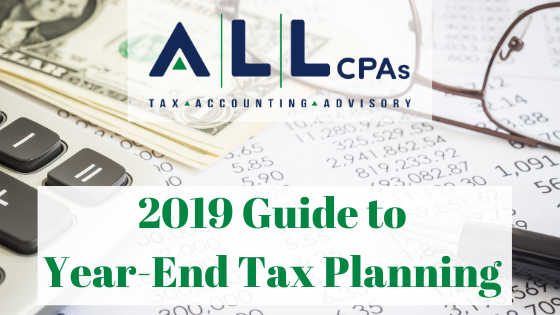
The Tax Cuts and Jobs Act (TCJA) of 2017 reduced tax rates for most individuals, introduced a new deduction for owners of sole proprietorships and pass-through entities, increased the standard deduction and, among other things, significantly increased the Alternative Minimum Tax (AMT) exemption and either limited or eliminated many other tax deductions. While the IRS continues to release guidance and update forms to reflect the changes, we offer the following tax planning guide that includes significant opportunities to minimize individual tax obligations.
CAPITAL GAINS
Income from an investment held for more than one year is generally taxed at preferential capital gains rates. For 2019, the long-term capital gain and qualified dividend rates remain unchanged at 0%, 15% or 20%, based on statutory income brackets and adjusted for inflation. For example, the 20% rate applies when taxable income exceeds $488,850 (married filing joint), $461,700 (head of household) or $434,550 (others).
Planning Opportunities:
- Consider holding capital assets for at least 12 months, as short-term capital gains are taxed at ordinary income rates.
- Consider gifting appreciated stock or mutual fund shares to relatives in a lower income tax bracket (such as children or grandchildren), who will pay less or no tax on the long-term capital gains when the shares are sold.
- Consider selling unrealized loss positions in your investment portfolio to offset capital gains recognized earlier in the year.
- Consider investments in Qualified Opportunity Funds, which allow investors to defer gain recognition.
NET INVESTMENT INCOME TAX (NIIT)
In addition to income tax, individual taxpayers with modified adjusted gross income (MAGI) of more than $200,000 per year ($250,000 if married filing joint; $125,000 if married filing separately) may be subject to net investment income tax. NIIT equals 3.8% of the lesser of (a) net investment income or (b) the amount by which MAGI exceeds the applicable threshold. Net investment income includes interest, dividends, capital gains, rental income (unless derived from ordinary business activities) and passive activities, less deductions properly allocated to net investment income.
Planning Opportunities:
- Consider electing installment sale treatment so that gains are spread over a number of years. By spreading the income over multiple years, current year net investment income and MAGI may be reduced to minimize or eliminate the 3.8% tax for the current and future tax years.
- Consider selling unrealized loss positions in your investment portfolio to offset capital gains recognized earlier in the year.
- Tax-exempt income is not subject to the 3.8% tax. Consider switching investments to tax-exempt investments if it makes sense for your portfolio. State taxation of such investments should also be considered.
SMALL BUSINESS OWNERS
If you own a business, consider the following strategies to minimize taxes:
- Defer income – If your business uses the cash method of accounting, you can defer billing and collections for products until year-end. If you use the accrual method, you can delay shipping products or delivering services.
- Accelerate Expenses – If you are a cash basis taxpayer, consider accelerating expenses by paying for business expenses by year-end. Credit card payments are deductible in the year charged rather than paid.
- Employ Your Child – If you are self-employed, consider employing your child to work in the family business. The child will be taxed at their rate on earnings (earnings are not subject to Kiddie Tax). Wages paid by sole proprietors to children age 17 or younger are exempt from Social Security, Medicare and federal unemployment taxes. Make sure wages paid are reasonable given the child’s age and work skills.
- Home Office Deduction – The TCJA suspended the home office deduction for employees who work from home. However, this deduction still applies if you are self-employed and have a home office that is used primarily for business activities.
- Acquire Assets – Acquiring business assets may be a good tax-planning strategy depending on your business situation. For assets with a useful life of more than one year, you generally must depreciate the cost over a period of years, depending on asset type. As a part of TCJA, the following favorable provisions were revised and made available for depreciating fixed assets, maximizing deductions:
- Section 179 Expensing Election – This election allows you to deduct 100% of the cost of qualifying assets rather than recovering them through depreciation. The maximum amount that can be expensed for 2019 is $1.02 million. This amount is reduced (but not below zero) by the amount by which the cost of total qualifying property exceeds $2.55 million.
- Bonus Depreciation – The TCJA establishes a 100% first-year deduction for qualified assets placed into service through December 31, 2022, with a recovery period of 20 years or less. This provision applies to both new and used property and was expanded to include qualified film, television and live theatrical productions. (For the period January 1, 2023 – December 31, 2026, bonus depreciation is scheduled to be gradually reduced.)
MEDICAL DEDUCTIONS
For 2019, medical expenses can be deducted to the extent the expenses exceed 10% of adjusted gross income (increased from 7.5% in 2018). Eligible expenses include health insurance premiums (if not deducted elsewhere on your income tax return), long-term care insurance premiums (subject to limitations), medical and dental services and prescription drugs. You may also deduct expenses paid for medical care of a child for whom you provide more than half of total support.
Planning Opportunities:
- Since individuals generally use cash basis accounting, medical expenses must be paid in the year incurred in order to be deductible. Credit card payments are deductible in the year charged, rather than paid. Be aware, however, that prepayment of medical services in advance of the year services are actually rendered may not accelerate the deduction.
- If possible, consider bunching elective medical procedures into alternating years (for services and purchases for which timing is within your control, without negatively impacting your or your family’s health) if it will help you exceed the 10% floor and if you have enough total itemized deductions to benefit from itemizing.
MORTGAGE INTEREST
For tax years 2018-2025, the TCJA reduces the limit on mortgage debt incurred after December 15, 2017, from $1 million to $750,000. Interest on debt incurred prior to December 15, 2017, but refinanced later, is deductible to the extent the new debt does not exceed the original debt. The TCJA also suspends the prior provision that allowed up to $100,000 of interest on home equity debt to be treated as deductible qualified residence interest.
Planning Opportunities:
- Keep track of how and when you spend proceeds of a loan. For example, if you used a portion of your mortgage debt to acquire business assets, that portion is deductible as trade or business interest or as investment interest expense.
- Elect out of treatment of debt secured by a qualified residence. This election allows you to characterize interest expense on home equity debt under the specified interest tracing rules and to preserve an otherwise nondeductible expense.
CHARITABLE DONATIONS
Year-end is a great time to make donations to qualified charities. Generally, cash donations to public charities are fully deductible up to 60% of adjusted gross income (AGI), and gifts of appreciated property or gifts for use by public charities are deductible up to 30% of AGI. This benefit only applies if you itemize deductions. For donations made during the year, be sure to get acknowledgment letters from the qualified charities for both cash and property (including stock donations) over $250. If you are not certain if a particular charity is qualified, you can consult the IRS website at http://apps.irs.gov/app/eos/ to search for the organization in question.
Planning Opportunities:
- Consider bunching donations into alternating years if your total itemized deductions on those years would surpass your standard deduction. A donor-advised fund allows donors to make a charitable contribution, receive an immediate tax deduction and then recommend grants from the fund over time.
- Donate appreciated stock to charity to avoid paying capital gains tax and get a fair market value deduction for stocks held for more than one year.
- Sell depreciated stock and donate the cash proceeds to charity. You will receive a charitable deduction as well as a capital loss benefit on the sale of stock. Capital losses offset capital gains, and any resulting net loss in future years offsets a maximum of $3,000 in ordinary income for a married filing joint taxpayer ($1,500 for all other taxpayers).
401(k) AND SEP CONTRIBUTIONS
Contributions to a traditional employer-sponsored defined contribution plan are typically pretax, therefore reducing taxable income. If you are an employee and your company offers a 401(k) plan, you should try to maximize your contribution to boost your retirement savings and save current year taxes. The maximum contribution to a 401(k) plan increased to $19,000 in 2019 (from $18,500 in 2018) and is scheduled to increase to $19,500 for 2020. Employees age 50 or older can also make an additional “catch-up” contribution of up to $6,000 (scheduled to increase to $6,500 in 2020.)
If you are self-employed, consider setting up a self-employed retirement plan (SEP) or some other type of retirement plan in order to maximize the allowable contribution each year.
QUALIFIED CHARITABLE DISTRIBUTIONS (QCD)
Taxpayers who have reached age 70½ can donate up to $100,000 of traditional and Roth IRA distributions directly to qualified charities. The donation satisfies the minimum distribution requirement and is excluded from taxable income. A charitable deduction cannot be claimed for the contribution.
HEALTH SAVINGS ACCOUNT (HSA)
If you are covered by a qualified high-deductible health plan, you can either contribute pretax income to an employer-sponsored Health Savings Account (HSA) or make deductible contributions to an HSA you set up yourself. For 2019, the maximum contributions are $3,500 for single taxpayers (increased from $3,450 in 2018) and $7,100 for family coverage (increased from $7,000 in 2018). Taxpayers aged 55 or older as of the end of the tax year can contribute an additional $1,000. (This means HSA holders can contribute and reduce income by $9,000 if both spouses are over 55.) There is no “use it or lose it” provision with HSAs, as you can carry over unused balances from year to year. Consider paying for qualified out-of-pocket medical expenses with personal funds rather than HSA funds. You can leave funds invested in your HSA to grow on a tax-deferred basis creating a pool of money to use for medical expenses later in life.
FLEXIBLE SPENDING ACCOUNT (FSA)
Amounts contributed to a healthcare Flexible Spending Account (FSA) are not subject to federal income, Social Security or Medicare taxes. For 2019, the maximum contribution is limited to $2,700 (increased from $2,650 in 2018). Historically, the “use it or lose it” provision applied to amounts contributed to a flexible spending account. However, there is a carryover provision which allows participating employees to carryover up to $500 of unused funds to the following year if your employer offers this option. Some employers may offer a grace period to incur eligible medical expenses, generally two-and-a-half months after year-end. Check with your employer for the rules on the established FSA plan.
If you wish to discuss tax planning strategy for the new rules that are generally going into effect for the 2019 tax year, please contact your ALL tax advisor or call us at 617-738-5200.
Recent Articles
Rising Construction Costs from COVID-19 Lead to New Bidding Approaches
Like other essential industries, t [...]
Nexus Requires Compliance and Begins by Filing Tax Returns
“Nexus” may sound like the name of [...]
The Impact You May See from the Build Back Better Act’s Tax Changes
The Build Back Better Act came und [...]




